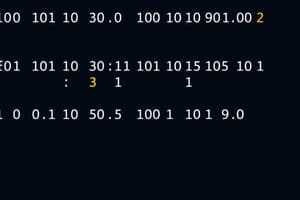Podcast
Questions and Answers
What is a necessary part of the basic syntax for a for loop in Python?
What is a necessary part of the basic syntax for a for loop in Python?
- An index variable
- The `break` statement
- A return statement
- Indentation for the code block (correct)
What will be the output of the following code?
for i in range(3, 6):
print(i)
What will be the output of the following code?
for i in range(3, 6):
print(i)
- 3 4 5 6 7
- 3 4 5 (correct)
- 3 4
- 3 4 5 6
What does the continue statement do in a for loop?
What does the continue statement do in a for loop?
- Terminates the loop entirely
- Skips to the next iteration of the loop (correct)
- Starts the loop over from the beginning
- Resets the loop counter
How can you loop over the keys of a dictionary in Python using a for loop?
How can you loop over the keys of a dictionary in Python using a for loop?
What happens when a break statement is executed inside a for loop?
What happens when a break statement is executed inside a for loop?
How can a for loop iterate over a string in Python?
How can a for loop iterate over a string in Python?
What will be printed by the following code?
for i in range(5):
if i == 3:
break
print(i)
What will be printed by the following code?
for i in range(5):
if i == 3:
break
print(i)
What is the purpose of the else clause in a for loop?
What is the purpose of the else clause in a for loop?
Flashcards
What is a Python for loop?
What is a Python for loop?
A for loop in Python iterates over a sequence, like a list, tuple, or string. It repeatedly executes a block of code for each item in the sequence.
What is the basic syntax of a for loop?
What is the basic syntax of a for loop?
The syntax involves the for keyword, a variable to store each item, the in keyword, and the sequence. Followed by a colon, the code block is indented.
How can you iterate through characters in a string?
How can you iterate through characters in a string?
Strings are sequences, so you can iterate through each character in a string using a for loop.
What is the range() function useful for in loops?
What is the range() function useful for in loops?
Signup and view all the flashcards
What does the break statement do in loops?
What does the break statement do in loops?
Signup and view all the flashcards
What does the continue statement do in loops?
What does the continue statement do in loops?
Signup and view all the flashcards
What are nested loops?
What are nested loops?
Signup and view all the flashcards
What does the else block do with for loops?
What does the else block do with for loops?
Signup and view all the flashcards
Study Notes
Python for Loops
- A
forloop iterates over a sequence (e.g., list, tuple, string, range). - It executes a code block repeatedly for each item in the sequence.
Basic Syntax
forkeyword followed by a variable name.inkeyword.- The sequence to iterate over.
- Colon (
:) to start the code block. - Indentation for the code block.
Iterating over Lists
- Example iterating over a list of numbers:
numbers = [1, 2, 3, 4, 5]
for number in numbers:
print(number)
- Prints each number on a new line.
Iterating over Strings
- Strings are iterable sequences.
- Access each character:
my_string = "hello"
for character in my_string:
print(character)
Iterating with range()
- Loops a specific number of times.
range(start, stop, step)creates a sequence of numbers. Defaults torange(0, stop, 1).- Example looping 5 times:
for i in range(5):
print(i)
- Example looping from 2 to 5 with a step of 2:
for i in range(2, 6, 2):
print(i)
break Statement
- Terminates the loop prematurely.
- Used when a specific condition is met:
for i in range(10):
if i == 5:
break
print(i)
continue Statement
- Skips the rest of the code block in the current iteration, moving to the next.
for i in range(5):
if i == 2:
continue
print(i)
Nested Loops
- Loops placed inside another loop.
- Inner loop completes all iterations per outer loop iteration.
rows = 2
cols = 3
for row in range(rows):
for col in range(cols):
print(f"({row},{col})")
else Clause (with loops)
- Executes a code block when the loop completes normally (without
break).
for i in range(3):
print(i)
else:
print("Loop completed normally")
Looping over Dictionaries
- Dictionaries are iterable.
- Iteration by default is over the keys.
my_dict = {"a": 1, "b": 2, "c": 3}
for key in my_dict:
print(key)
## Access values:
for key in my_dict:
print(f"Key: {key}, Value: {my_dict[key]}")
Looping over enumerate
enumerate()function provides both index and value of an iterable.
my_list = ["apple", "banana", "cherry"]
for index, item in enumerate(my_list):
print(f"Index: {index}, Item: {item}")
Important Considerations
- Python's indentation is crucial.
- Ensure the sequence being iterated over is valid.
- Avoid infinite loops.
- Choose the correct loop type (e.g.,
forfor sequences,whilefor conditions).
Studying That Suits You
Use AI to generate personalized quizzes and flashcards to suit your learning preferences.





